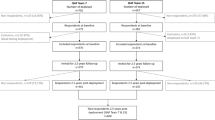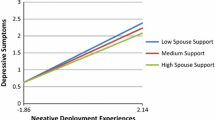Abstract
Suicide rates within the military have continued to rise in recent years, resulting in re-doubled efforts to understand and remedy this trend. In an attempt to clarify unique pathways to suicide risk in this population, the current study examined the relationship between length of time since most recent deployment and several suicide risk factors (hopelessness, suicidal ideation, and resolved plans and preparations). Furthermore, this study examined the moderating influence of post-deployment social support in the prediction of suicide risk. Results indicated that the interaction of time since deployment and post-deployment support predicted both hopelessness and resolved plans and preparations, but did not predict suicidal ideation. These findings suggest that the negative effects of time spent away from recognized military support may be compounded by the isolating effect of decreased access to alternative supports at home, resulting in increased hopelessness and/or resolved plans and preparations. Implications for the necessity of improved post-deployment programs are discussed.
Similar content being viewed by others
References
Beck, A. T., & Steer, R. A. (1991). Manual for Beck Scale for Suicide Ideation. San Antonio, TX: Psychological Corporation.
Beck, A. T., Weissman, A., Lester, D., & Trexler, L. (1974). The measurement of pessimism: The Hopelessness Scale. Journal of Consulting and Clinical Psychology, 42, 861–865.
Blocker, G. M., & Miller, J. A. (2013). Unintended consequences: Stigma and suicide prevention efforts. Military Medicine, 178, 473.
Bryan, C. J. (2011). The clinical utility of a brief measure of perceived burdensomeness an thwarted belongingness for the detection of suicidal military personnel. Journal of Clinical Psychology, 67, 981–992.
Bryan, C. J., Clemans, T. A., & Hernandez, A. M. (2012). Perceived burdensomeness, fearlessness of death, and suicidality among deployed military personnel. Personality and Individual Differences, 52, 374–379.
Bryan, C. J., & Hernandez, A. M. (2013). The functions of social support as protective factors for suicidal ideation in a sample of air force personnel. Suicide and Life-Threatening Behavior, 43, 562–573.
Bryan, C. J., McNaughton-Cassil, M., & Osman, A. (2013). Age and belongingness moderate the effects of combat exposure on suicidal ideation among active duty military personnel. Journal of Affective Disorders, 150, 1226–1229.
Carretta, C. M., Ridner, S. H., & Dietrich, M. S. (2014). Hope, hopelessness, and anxiety: a pilot instrument comparison study. Archives of Psychiatric Nursing, 28, 230–234.
Centers for Disease Control and Prevention. (2015). Web-Based Injury Statistics Query and Reporting System (WISQARS). Available at http://www.cdc.gov/injury/wisqars/index.html. Accessed 9 Jan 2015.
DeBeer, B. B., Kimbrel, N. A., Meyer, E. C., Gulliver, S. B., & Morissette, S. B. (2014). Combined PTD and depressive symptoms interact with post-deployment social support to predict suicidal ideation on Operation Enduring Freedom and Operation Iraqi Freedom veterans. Psychiatry Research, 216, 357–362.
Durkheim, Emile (1897) [1951]. Suicide: a study in sociology. Glencoe, The Free Press
Griffith, J. (2012a). Suicide in the army national guard: An empirical inquiry. Suicide and Life-Threatening Behavior, 42, 104–119.
Griffith, J. (2012b). Correlates of suicide among army national guard soldiers. Military Psychology, 24, 568–591.
Hayes, A. F. (2013). Introduction to mediation, moderation, and conditional process analysis: A regression-based approach. New York, NY: Gulford Press.
Hoge, C. W., & Castro, C. A. (2012). Preventing suicides in US service members and veterans: Concerns after a decade of war. Journal of the American Medical Association, 308, 671–672.
Holden, R. R., & DeLisle, M. M. (2005). Factor analysis of the Beck scale for suicide ideation with female suicide attempters. Assessment, 12, 231–238.
Jakupcak, M., Hoerster, K. D., Varra, A., Vannoy, S., Felker, B., & Hunt, S. (2011). Hopelessness and suicidal ideation in Iraq and Afghanistan war veterans reporting subthreshold and threshold posttraumatic stress disorder. The Journal of Nervous and Mental Disease, 199, 272–275.
Joiner, T. E. (2005). Why people die by suicide. Boston, MA: Harvard University Press.
Joiner, T. E., Pfaff, J. J., & Acres, J. G. (2002). A brief screening tool for suicidal symptoms in adolescents and young adults in general health settings: Reliability and validity data from the Australian National General Practice Youth Suicide Prevention Project. Behaviour Research and Therapy, 40, 471–481.
Joiner, T. E., & Rudd, M. D. (1996). Disentangling the interrelations between hopelessness, loneliness, and suicidal ideation. Suicide and Life-Threatening Behavior, 26, 19–26.
Joiner, T. E, Jr, Rudd, M. D., & Rajab, M. H. (1997). The modified scale for suicidal ideation: Factors of suicidality and their relation to clinical and diagnostic variables. Journal of Abnormal Psychology, 106, 260–265.
Joiner, T. E., Steer, R. A., Abramson, L. Y., Alloy, L. B., Metalsky, G. I., & Schmidt, N. B. (2001). Hopelessness depression as a distinct dimension of depressive symptoms among clinical and non-clinical samples. Behaviour Research and Therapy, 39, 523–536.
Kapur, N., While, D., Blatchley, N., Bray, I., & Harrison, K. (2009). Suicide after leaving the UK Armed Forces—A cohort Study. PLoS Medicine, 6, e1000026.
King, D. W., King, L. A., & Vogt, D. S. (2003). Manual for the deployment risk and resilience inventory (DRRI): A collection of measures for studying deployment-related experiences of military veterans. Boston, MA: National Center for PTSD.
Kline, A., Ciccone, D. S., Falca-Dodson, M., Black, C. M., & Losonczy, M. (2011). Suicidal ideation among national guard troops deployed to Iraq: the association with postdeployment readjustment problems. The Journal of Nervous and Mental Disease, 199, 914–920.
LeardMann, C. A., Powell, T. M., Smith, T. C., Bell, M. R., Smith, B., Boyko, E. J., et al. (2013). Risk factors associated with suicide in current and former US military personnel. JAMA, 310, 496–506.
Mann, J. J., Waternaux, C., Haas, G. L., & Malone, K. M. (1999). Toward a Clinical Model of Suicidal Behavior in Psychiatric Patients. American Journal of Psychiatry, 156, 181–189.
Metalsky, G., & Joiner, T. (1997). The Hopelessness Depression Symptom Questionnaire. Cognitive Therapy and Research, 21, 359–384.
National Center for Telehealth and Technology, Defense Centers for Psychological Health. (2013). Department of Defense Suicide Event Report (DoDSER): calendar year 2012 report.
O’Connor, R. C. (2011). Towards an integrated motivational-volitional model of suicidal behaviour. In R. C. O’Connor, S. Platts, & J. Gordon (Eds.), International handbook of suicide prevention: research, policy and practice (pp. 181–198). Chichester: John Wiley and Sons.
Pfeiffer, P. N., Brandfon, S., Garcia, E., Duffy, S., Ganoczy, D., Myra Kim, H., & Valenstein, M. (2014). Predictors of suicidal ideation among depressed veterans and the interpersonal theory of suicide. Journal of Affect Disorders, 152–154, 227–281.
Pietrzak, R. H., Johnson, D. C., Goldstein, M. B., Malley, J. C., Rivers, A. J., Morgan, C. A., & Southwick, S. M. (2010a). Psychosocial buffers of traumatic stress, depressive symptoms, and psychosocial difficulties in veterans of Operations Enduring Freedom and Iraqui Freedom: the role of resilience, unit support, and postdeployment social support. Journal of Affect Disorders, 120, 188–192.
Pietrzak, R. H., Johnson, D. C., Goldstein, M. B., Malley, J. C., & Southwick, S. M. (2009). Psychological resilience and postdeployment social support protect against traumatic stress and depressive symptoms in soldiers returning from operations enduring freedom and Iraqi freedom. Depression and Anxiety, 26, 745–751.
Pietrzak, R. H., Russo, A. R., Ling, Q., & Southwick, S. M. (2010b). Suicidal ideation in treatment-seeking veterans of Operations Enduring Freedom and Iraqi Freedom: The role of coping strategies, resilience, and social support. Journal of Psychiatric Research, 45, 720–726.
Ramchand, R., Acosta, J., Burns, R. M., Jaycox, L. H., & Pernin, C. G. (2011). The war within: Preventing suicide in the US military. Santa Monica, CA: RAND Corporation.
Rosellini, A. J., & Bagge, C. L. (2014). Temperament. Hopelessness, and attempted suicide: Direct and indirect effects, suicide and life-threatening behavior, 44, 353–361.
Rudd, M. D. (2013). Suicide in the military. In B. A. Moore & J. E. Barnett (Eds.), Military psychologists’ desk reference (pp. 143–147). New York, NY, US: Oxford University Press.
Schotte, D. E., & Clum, G. A. (1987). Problem-solving skills in suicidal psychiatric patients. Journal of Consult Clinical Psychology, 55, 49–55.
Steed, L. (1991). Further validity and reliability evidence for Beck Hopelessness Scale Scores in a nonclinical sample. Educational and Psychological Measurement, 61, 303–316.
Steer, R. A., Rissmiller, D. B., Ranieri, W. F., & Beck, A. T. (1993). Dimensions of suicidal ideation in psychiatric inpatients. Behaviour Research and Therapy, 31, 229–236. doi:10.1016/0005-7967(93)90090-H.
Vogt, D. S., Proctor, S. P., King, D. W., King, L. A., & Vasterling, J. J. (2008). Validation of scales from the Deployment Risk and Resilience Inventory in a sample of Operation Iraqi Freedom veterans. Assessment, 15, 391–403.
Zhang, J., & Li, Z. (2013). The association between depression and suicide when hopelessness is controlled for. Comprehensive Psychiatry, 54, 790–796.
Acknowledgments
This work was in part supported by the Military Suicide Research Consortium (MSRC), an effort supported by the Office of the Assistant Secretary of Defense for Health Affairs under Award No. (W81XWH-10-2-0181). Opinions, interpretations, conclusions and recommendations are those of the author and are not necessarily endorsed by the MSRC or the Department of Defense.
Author information
Authors and Affiliations
Corresponding author
Ethics declarations
Conflicts of Interest
Rachel L. Martin, Claire Houtsma, Bradley A. Green, Michael D. Anestis declare that they have no conflict of interest, financial or otherwise.
Informed Consent
All procedures followed were in accordance with relevant regulatory bodies. Informed consent was obtained from all participants prior to participation in the protocol.
Animal Rights
No animal studies were carried out by the authors for this article.
Rights and permissions
About this article
Cite this article
Martin, R.L., Houtsma, C., Green, B.A. et al. Support Systems: How Post-Deployment Support Impacts Suicide Risk Factors in the United States Army National Guard. Cogn Ther Res 40, 14–21 (2016). https://doi.org/10.1007/s10608-015-9719-z
Published:
Issue Date:
DOI: https://doi.org/10.1007/s10608-015-9719-z




